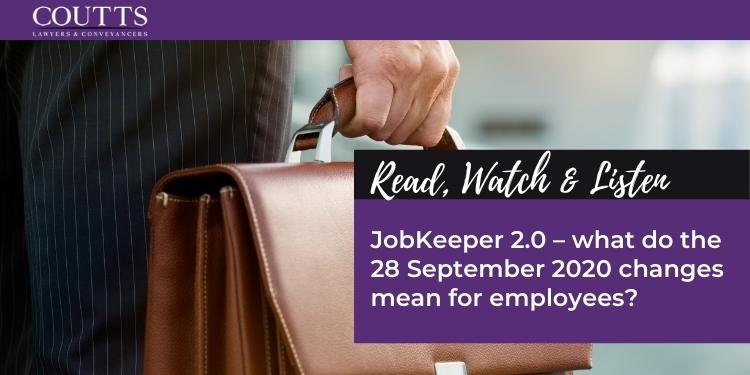In response to the continued economic difficulties Australians are facing, the Australian government has announced big changes to the JobKeeper Scheme. Among other changes surrounding eligibility and the test to be met, the government also announced the JobKeeper payment will continue until 28 March 2021, and further, that the sum of the payments will operate as a tiered system.
KEY TAKE OUTS:
- From 3 August 2020, the relevant date of employment for employees on JobKeeper is 1 July 2020 (replacing 1 March 2020);
- From 28 September 2020, the JobKeeper payment will be reduced, and paid at two rates according to the hours worked by the employee:
- For the period between 28 September to 3 January 2021:
- $1,200.00 a fortnight for employees who worked for 20 hours or more a week (on average); or
- $750 a fortnight for employees who worked less than 20 hours a week (on average).
- For the period between 28 September to 3 January 2021:
- From 4 January 2021, the JobKeeper payment will be reduced again, and will be paid at two rates according to the hours worked:
- For the period between 4 January 2021 and 28 March 2021:
- $1,000.00 a fortnight for employees who worked 20 hours or more a week (on average); or
- $650.00 a fortnight for employees who worked less than 20 hours a week (on average).
- For the period between 4 January 2021 and 28 March 2021:
Increasing employee’s eligibility: change of date of employment
Effective 3 August 2020, the government has amended the ‘relevant date of employment’ to 1 July 2020 (previously 1 March 2020). This will mean the eligibility of employees is extended to include employees that started their employment as at 1 July 2020 (as opposed to 1 March 2020). This amendment will greatly increase the number of individuals that are eligible to receive JobKeeper, including those who were deemed ineligible under the previous relevant date of employment and those stood down or re-hired.
Employees who were not previously eligible to receive JobKeeper due to their employment date, should now review:
- whether their employer is receiving JobKeeper; and
- If so, whether they are now eligible to receiving the JobKeeper payment, due to the amendment to the relevant date of employment.
In order to receive the JobKeeper payment, employees will also have to meet further eligibility tests, such as not receiving paid parental leave for the period in which they are claiming JobKeeper. Further information regarding the additional tests can be found here.
Employees who were eligible for the JobKeeper payment before 3 August 2020 will not need to be re-assessed, and will continue to be eligible for the payments after 3 August 2020.
Decreasing the payment: change to the rates of JobKeeper payments
From 30 March 2020, to 27 September 2020, the JobKeeper payment is $1,500.00 per fortnight.
Effective 28 September 2020, the JobKeeper payment will be reduced and will operate as a two-tiered structure, based on the hours worked by the employee (detailed in the table below). In January 2021, the JobKeeper payment will be further reduced and will continue to operate as a two-tiered system:
| Period | Employees who work 20 hours or more per week | Employees who work 20 hours or less per week |
| From 28 September 2020 to 3 January 2021 | $1,200.00 | $750.00 |
| From 4 January 2021 to 28 March 2021 | $1,000.00 | $650.00 |
It is important to note that these figures are before tax, meaning that employees will actually receive less than the figures quoted.
The hours worked will be based on the average amount of hours worked per week, during the month of February 2020 (or June 2020, under the extended JobKeeper scheme). In the circumstances where an employees hours were not usual during this assessment period (for example, if an employee was on leave, or was only employed for part of February 2020 or June 2020), the Commissioner of Taxation will have the discretion to set out alternative tests to meet.
The next steps
If, based on these changes, you think you may now be eligible to receive JobKeeper from your employer, you should:
- Visit the Australian Taxation Office website to check you meet the eligibility requirements: https://www.ato.gov.au/general/JobKeeper-payment/employees/ ;
- Talk to your employer, to ascertain if they are an eligible business who is receiving JobKeeper (or is about to receive JobKeeper);
- Let your employer know that you want them to claim the JobKeeper payment for you. If you have multiple jobs, you will need to choose one employer only to claim the JobKeeper payment;
- Complete the JobKeeper employee nomination notice provided by your employer, and return it to them; and
- If you are receiving additional income support (such as JobSeeker payment), let Services Australia know that you will be receiving JobKeeper. Failure to do so may result in a debt that you will be required to pay back.
Conclusion
The various amendments, eligibility tests, and requirements can become very overwhelming for employees in such an uncertain time. If you are unsure about your employment law rights in light of coronavirus, any of the amendments due to commence in the near future, or the operation of the current JobKeeper scheme, it is important that you seek professional legal advice as soon as possible.
Coutts’ employment law team can guide you through your employment law rights in the midst of a global epidemic, the current operation of JobKeeper and the imminent changes, and provide legal advice to you in relation to JobKeepers’ intersection with employment law generally.
This blog is merely general and non-specific information on the subject matter and is not and should not be considered or relied on as legal advice. Coutts is not responsible for any cost, expense, loss or liability whatsoever in relation to this blog, including all or any reliance on this blog or use or application of this blog by you.



